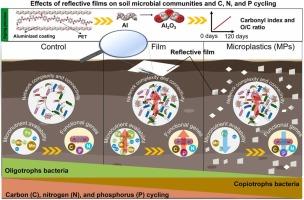铝和微塑料从反射农膜释放破坏土壤中的微生物群落和功能
IF 11.3
1区 环境科学与生态学
Q1 ENGINEERING, ENVIRONMENTAL
引用次数: 0
摘要
反光农膜广泛应用于蔬菜生产和果园,具有驱虫、催熟、增产的作用。这些薄膜由铝(Al)金属化的塑料基底组成,随着时间的推移在土壤中降解,释放出铝和微塑料。本研究研究了铝涂层反射膜(聚对苯二甲酸乙二醇酯,pet基)在紫外线辐射、模拟降雨和土壤掩埋下长达120天的老化和风化,评估了释放的铝和微塑料对土壤化学和微生物群落的影响。傅里叶变换红外光谱(FTIR)和x射线光电子能谱(XPS)显示,风化作用由C - O/C=O官能团的形成、羰基指数的增加和Al氧化成Al₂O₃证实。在土壤环境中观察到更快的al包覆脱落和PET氧化。来自薄膜的微塑料(0.5% w/w)降低了土壤微量营养素的有效性(Fe, Mn, Cu),抑制了参与碳,氮和磷循环的功能基因,并使微生物群落向低营养细菌(如RB41, Candidatus_Udaeobacter, gemmatimonadees和Chloroflexi)的富集转移,同时减少了共营养细菌(如Sphingomonas, Ellin6067, Dongia, Puia和Flavisolibacter)。因此,这些发现表明,反射膜风化强烈地改变了土壤养分含量和微生物群落组成,对土壤健康和农业可持续性具有潜在的影响。本文章由计算机程序翻译,如有差异,请以英文原文为准。

Aluminum and microplastic release from reflective agricultural films disrupt microbial communities and functions in soil
Reflective agricultural films are widely used in vegetable production and orchards to repel pests, accelerate fruit ripening, and boost yields. These films, composed of a plastic base metallized with aluminum (Al), degrade over time in soil, releasing Al and microplastics. This study investigated the aging and weathering of Al-coated reflective films (polyethylene terephthalate, PET-based) under UV radiation, simulated rainfall, and soil burial for up to 120 days, assessing the effects of released Al and microplastics on soil chemistry and microbial communities. Weathering was confirmed by the formation of C–O/C![]() O functional groups, an increasing carbonyl index, and the oxidation of Al to Al₂O₃, as shown by Fourier-transform infrared (FTIR) and X-ray photoelectron spectroscopy (XPS). Faster Al-coated shedding and PET oxidation were observed in the soil environment. Microplastics (0.5 % w/w) from the films reduced soil micronutrient availability (Fe, Mn, Cu), suppressed functional genes involved in carbon, nitrogen, and phosphorus cycling, and shifted microbial communities towards oligotrophic bacteria enrichment (e.g., RB41, Candidatus_Udaeobacter, Gemmatimonadetes, and Chloroflexi) while reducing copiotrophic bacteria (e.g., Sphingomonas, Ellin6067, Dongia, Puia, and Flavisolibacter). Therefore, these findings highlight that reflective film weathering strongly alters soil nutrient content and microbial community composition, with potential implications for soil health and agricultural sustainability.
O functional groups, an increasing carbonyl index, and the oxidation of Al to Al₂O₃, as shown by Fourier-transform infrared (FTIR) and X-ray photoelectron spectroscopy (XPS). Faster Al-coated shedding and PET oxidation were observed in the soil environment. Microplastics (0.5 % w/w) from the films reduced soil micronutrient availability (Fe, Mn, Cu), suppressed functional genes involved in carbon, nitrogen, and phosphorus cycling, and shifted microbial communities towards oligotrophic bacteria enrichment (e.g., RB41, Candidatus_Udaeobacter, Gemmatimonadetes, and Chloroflexi) while reducing copiotrophic bacteria (e.g., Sphingomonas, Ellin6067, Dongia, Puia, and Flavisolibacter). Therefore, these findings highlight that reflective film weathering strongly alters soil nutrient content and microbial community composition, with potential implications for soil health and agricultural sustainability.
求助全文
通过发布文献求助,成功后即可免费获取论文全文。
去求助
来源期刊

Journal of Hazardous Materials
工程技术-工程:环境
CiteScore
25.40
自引率
5.90%
发文量
3059
审稿时长
58 days
期刊介绍:
The Journal of Hazardous Materials serves as a global platform for promoting cutting-edge research in the field of Environmental Science and Engineering. Our publication features a wide range of articles, including full-length research papers, review articles, and perspectives, with the aim of enhancing our understanding of the dangers and risks associated with various materials concerning public health and the environment. It is important to note that the term "environmental contaminants" refers specifically to substances that pose hazardous effects through contamination, while excluding those that do not have such impacts on the environment or human health. Moreover, we emphasize the distinction between wastes and hazardous materials in order to provide further clarity on the scope of the journal. We have a keen interest in exploring specific compounds and microbial agents that have adverse effects on the environment.
 求助内容:
求助内容: 应助结果提醒方式:
应助结果提醒方式:


